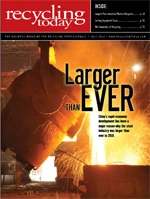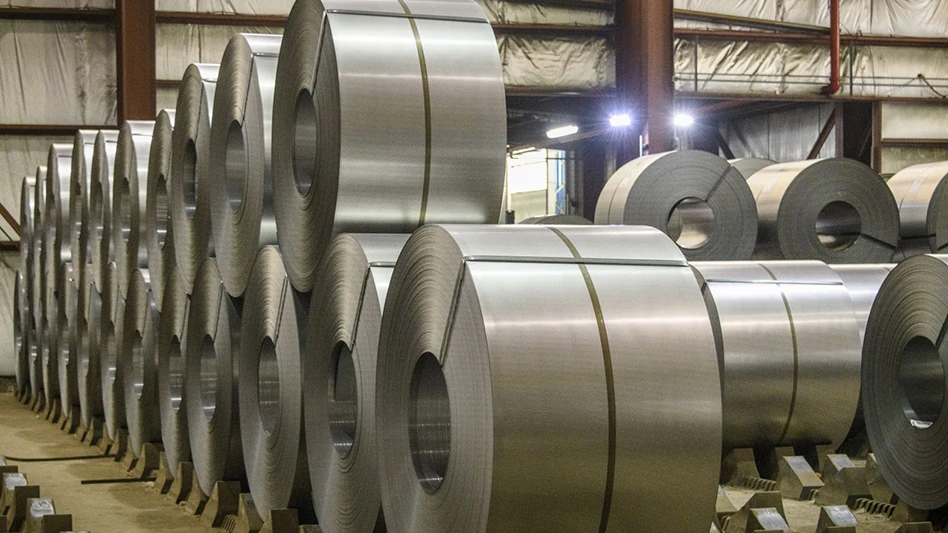Being able to separate wanted from unwanted material has always been the goal in the recycling industry, and with good reason: Knowing the type or quality of the material coming into a yard prevents pricing errors and helps supply the cleanest scrap material to customers. It saves scrap recyclers time and provides them with the most profit.
High-quality separated materials produce the highest quality final product. If manufacturers, fabricators and smelting operations feel confident that recyclers can supply the material they want at the purity they need, it creates a win-win situation: They know they can rely on their suppliers, and the recyclers get long-term customers.
SORTING ADVANCES
Scrap metal sorting has come a long way since the “watch for the color of the grinding spark” days. Today, large auto shredding facilities and small feeder yards specializing in retail sales have moved on to a more technological sorting process.
Most scrap processors are familiar with using magnets and eddy-current separators to sort and separate ferrous metals from nonferrous metals and with using analyzers that incorporate optical emission spectrometers (OES). These are known as arc/spark analyzers because they create a spark that causes electrons to emit light waves.
X-ray fluorescence, or XRF, analysis also can be a fast, accurate and relatively easy way to detect and separate metal alloys and grades. Correct sorting allows recyclers to accurately price the material coming into their yards and to provide a purer scrap product to their customers.
Throughout the past decade or so, XRF analyzers have been miniaturized into handheld units, but the method also is available for online sorting of bulk materials, for example in the case of shredding operations. So whatever the size of the scrap operation, XRF sorting equipment potentially can have a place in it.
XRF EXPLAINED
Nearly all elements, from iron to copper to zinc to tungsten, have unique and known X-ray signatures. When an X-ray or gamma ray is absorbed by an element, the element fluoresces, or emits energy. Inner-shell atomic fluorescence produces the X-ray signature, which can be “captured” and reported.
XRF analyzers do both tasks: They provide the incident X-rays that generate the excitation in the atoms and then they detect the fluorescence from most of the elements in the sample material. (XRF analysis generally cannot detect and measure “lighter” elements, such as carbon.)
Based on this, XRF equipment also will provide an analysis of which elements comprise the sample and at what percentages. Most also will provide grade identification, based on a comparison between the compositional analysis results and a grade specification library.
XRF analysis can detect multiple elements simultaneously, which makes it an option for sorting grades of stainless steel or aluminum and for separating glass by color.
METAL APPLICATIONS
XRF has traditionally been used for basic stainless, nickel and alloy grade sorting and separation; however, advances in the technology have allowed it to move into more advanced detection tasks.
XRF analyzers can sort 304 stainless from higher value 316 because they can detect the approximately 2 percent of molybdenum that is in the 316 stainless.
Stainless 304 and 347 both have chromium and nickel as well as other elements, but they have different niobium content. XRF analysis can detect each element’s concentration and help to sort the alloys using a test that can take less than one second to complete.
For light alloys, XRF analyzers typically have been limited to the separation of gross alloy series (for example, 2000 from 7000 series aluminum alloys). OES has traditionally been the portable technology of choice for sorting aluminum alloys. But with recent advances in handheld XRF technology, these analyzers now can be used for more extensive grade separation within a series.
A common wrought aluminum alloy, 3003, is recognizable based on its manganese content. Sorting 3003 from other aluminum series alloys has been straightforward with handheld XRF for years. With current handheld XRF analyzers, though, further separation of 3003 from 3004 and 3005 based on small amounts of magnesium—a light element just recently possible to analyze with good precision—is possible.
But grade separation is not about just one element. Aluminum grades 6061 an 6063 have the same 11 elements and no others. The latest advancements in XRF analysis can determine grade based on the elemental percentages detected using a short test.
Being able to detect and separate alloy grades and to examine material for residuals or poisons can create incremental value, happy customers and, ultimately, nice profits.
BEYOND THE BASICS
XRF analyzers are designed to separate meatballs (electric motors consisting of copper wire wound around iron cores), glass and nonferrous metals in high-speed sorting systems.
Meatballs. Meatballs generally cannot be separated efficiently from shredded scrap streams using eddy current or OES technology. Because eddy currents create a magnetic field, the iron in the meatballs will be attracted to the magnet, just like every other piece of ferrous scrap. Optical emission sparking can be too narrowly focused to detect all the metals in the meatball without multiple tests. Manual separation can be slow, labor intensive and prone to error.
XRF analysis, however, works at the elemental level to detect the copper in the meatball in a single pass and can allow automatic sorting to follow.
Glass. Ceramic glass—the kind used in cookware—cannot be mixed with standard glass if the cullet is to be recycled. Ceramic glass has a different melting temperature than bottle or container glass (“regular” glass), which results in inclusions/defects in the new glass. Different melting temperatures also can damage production equipment.
Leaded glass, like that from CRTs (cathode ray tubes), crystal goblets and chandeliers, can cause the same problems as ceramic glass in the manufacturing process.
XRF analyzers are designed to quickly and accurately detect these types of glass.
Colored glass gets its color from metals: cobalt for blue, iron for green and sulfur or carbon for amber or brown glass. Recycled glass retains its color, so the cleaner the cullet a recycler supplies the truer the color of the final product.
XRF sorting equipment can be calibrated to detect these metals. Multiple XRF systems can be employed to separate clear, amber, green and blue glass.
Aluminum Grades. While a simple weight or magnetic test can be used to separate aluminum from other metals, determining the difference between types of aluminum has always been a challenge. For example, 7000 series aluminum alloys appear visually the same as 6000 series alloys. XRF analysis can sort 7000 series from 6000 series as well as other grades in these series.
EMPLOYING XRF
XRF analysis can be used in a range of recycling facilities and for a range of scrap sorting needs.
Automobile shredding operations can incorporate XRF technology into existing sorters to further refine separation. For instance, XRF analyzers can be added after an eddy current to further separate ferrous items that also contain wanted (or unwanted) metals and are designed to provide quick detection.
Handheld XRF analyzers can accompany an operator to a demolition site to determine the type of material the site contains, allowing a recycler to bid accurately (and possibly more quickly than competitors).
Detection using XRF analyzers is user configurable and can be changed based on the requirements of the task.
The current state of XRF technology can detect elements from magnesium to uranium, with ever improving sensitivities. As such, the breadth of material that can be sorted using this technology continues expanding.

Explore the July 2011 Issue
Check out more from this issue and find your next story to read.
Latest from Recycling Today
- P+PB adds new board members
- BlueScope, BHP & Rio Tinto select site for electric smelting furnace pilot plant
- Magnomer joins Canada Plastics Pact
- Out of touch with reality
- Electra names new CFO
- WM of Pennsylvania awarded RNG vehicle funding
- Nucor receives West Virginia funding assist
- Ferrous market ends 2024 in familiar rut





